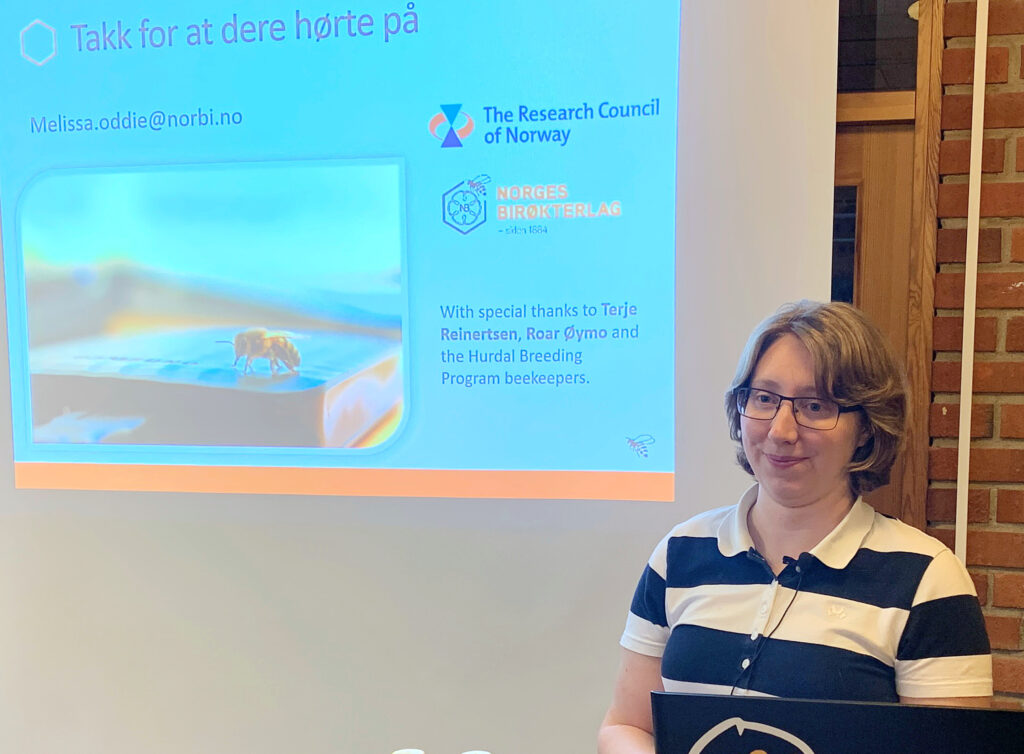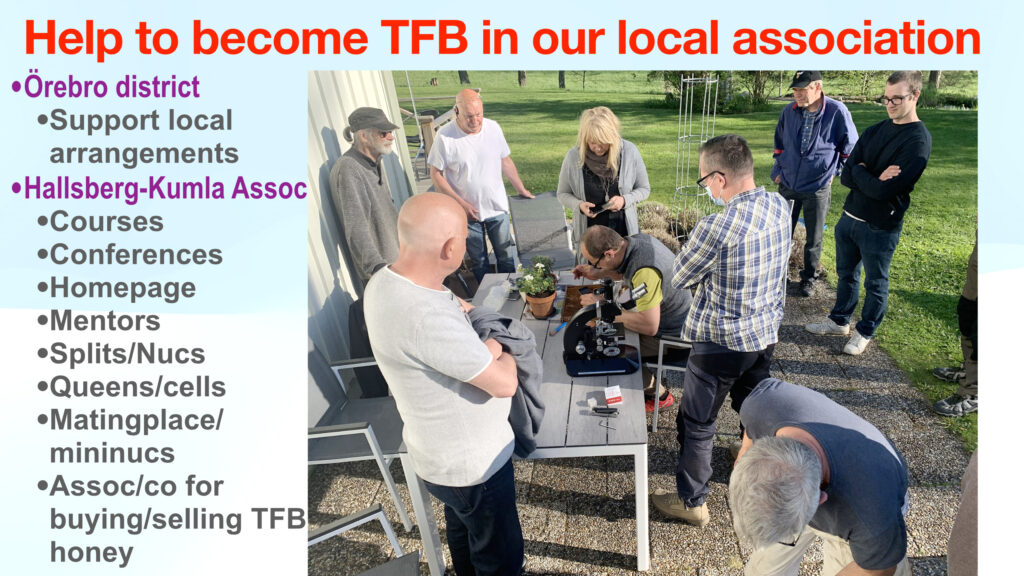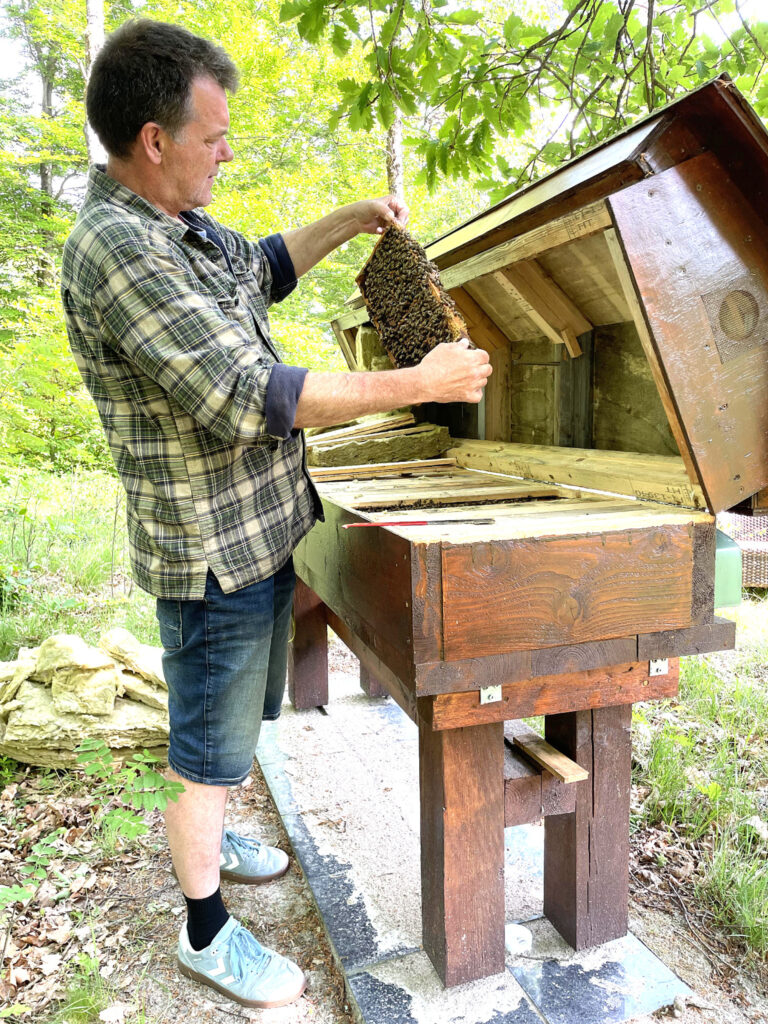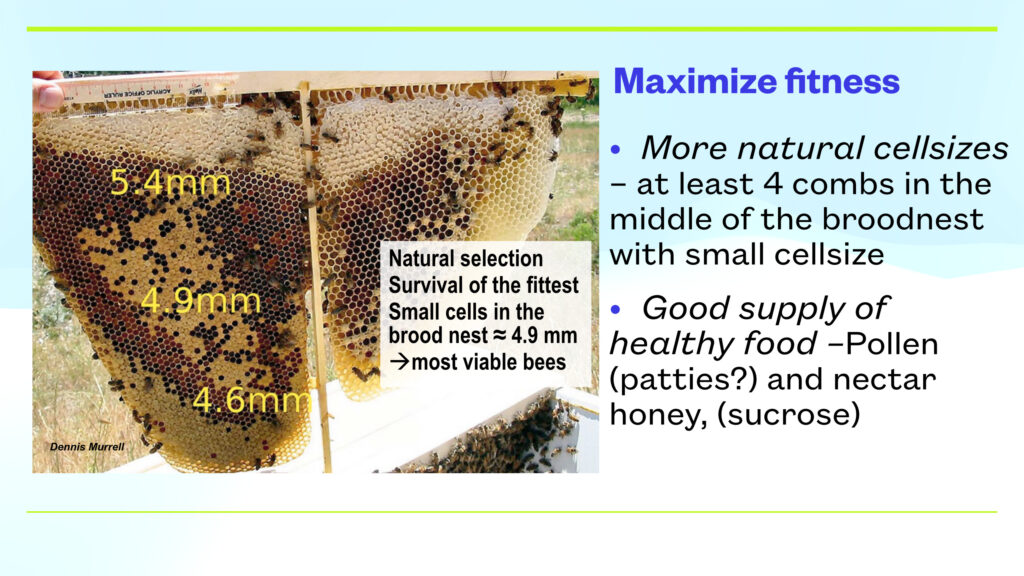Hallsberg annual conference 2023
In November 2023, the fifth annual conference on treatment-free/varroa-resistant bees was held in Hallsberg. The number of beekeepers with treatment-free bees is increasing in the Hallsberg area and elsewhere in Sweden. This time Dr. Melissa Oddie from Norway was the main speaker. Around 60 beekeepers from all over Sweden were gathered. Half were treatment-free and half were planning to become so.
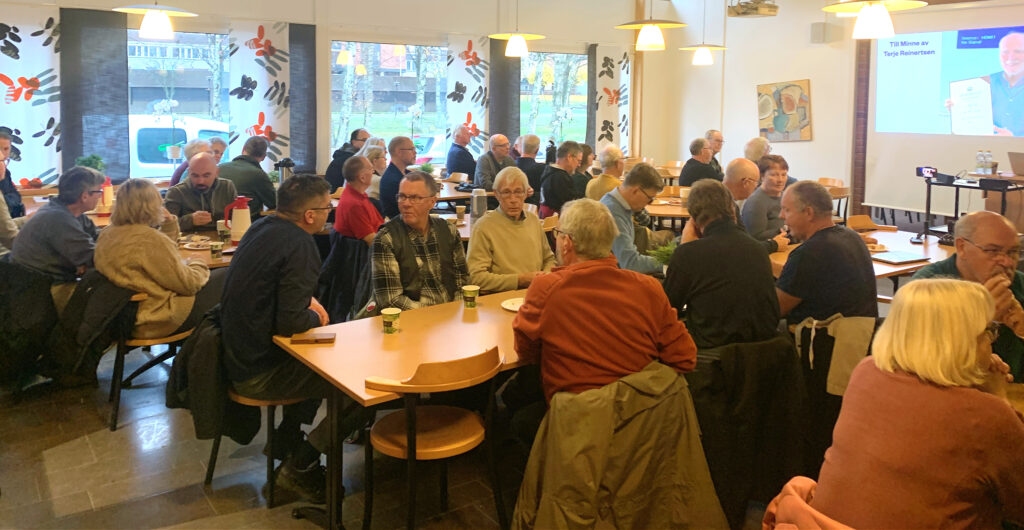
Treatment-free means that no “crutches” are used in beekeeping. Beekeeping is basically as it was before the varroa arrived. The bees keep the mites in check. Beekeepers have learned how to help them become treatment-free. No chemicals, synthetic or organic, are used, nor any special measures, such as cutting drone brood.
To be treatment-free, the bees in an apiary must be sufficiently varroa resistant. Increased virus resistance is good. It is important to develop a group of bee colonies, not just individuals. New queens are mated in the apiary(s). The proximity to other non-treatment-free bee colonies plays a role, and how many there are. Experience has shown and demonstrates how such relationships can look and function. The dynamics of a treatment-free and a treated colony are somewhat different.
One definition of varroa resistance is the ability of bees to reduce varroa levels to a survivable level by themselves. Varroa tolerance is the ability to survive despite the presence of a fluctuating population of mites.
Treatment free efforts in Sweden
There has been research in Sweden aimed at varroa resistance, with support from the Swedish Board of Agriculture. Before the conference, Per Ideström, former member of the SBR board, had asked authorities (SJV), beekeepers’ organization (SBR) and universities (SLU) whether they have activities to help beekeepers achieve treatmentfree bees. He reported from his conversations at the conference.
Ideström stated that these organizations currently have no such activities. The conversation with the Swedish Board of Agriculture ended with a positive interest in what the conference is about. SBR also takes a positive view of the activities in Hallsberg. There has been research for many years at SLU on varroa resistant bees. We look forward to more activities for varroa resistance.
The research of Dr Melissa Oddie
Melissa Oddie comes from Canada and took her PhD at the University of Bern, Switzerland. It was about Varroa destructor and varroa resistant bees. She has been researching varroa resistance for 7 years and is now responsible for a resistance breeding program for a Carniolan population in Norway.
Melissa earned her PhD studying Terje Reinertsen’s varroa resistant bees in Norway. His bees are mostly of Buckfast origin. They have been resistant for more than 25 years. In March 2023, he received the Norwegian King’s Medal for his contribution to beekeeping. In early November 2023, he died very shortly after being diagnosed with cancer. We are grateful that he was able to visit us and attend the Hallsberg Conference in 2022. We remember him with gratitude. He has meant a lot to beekeeping.
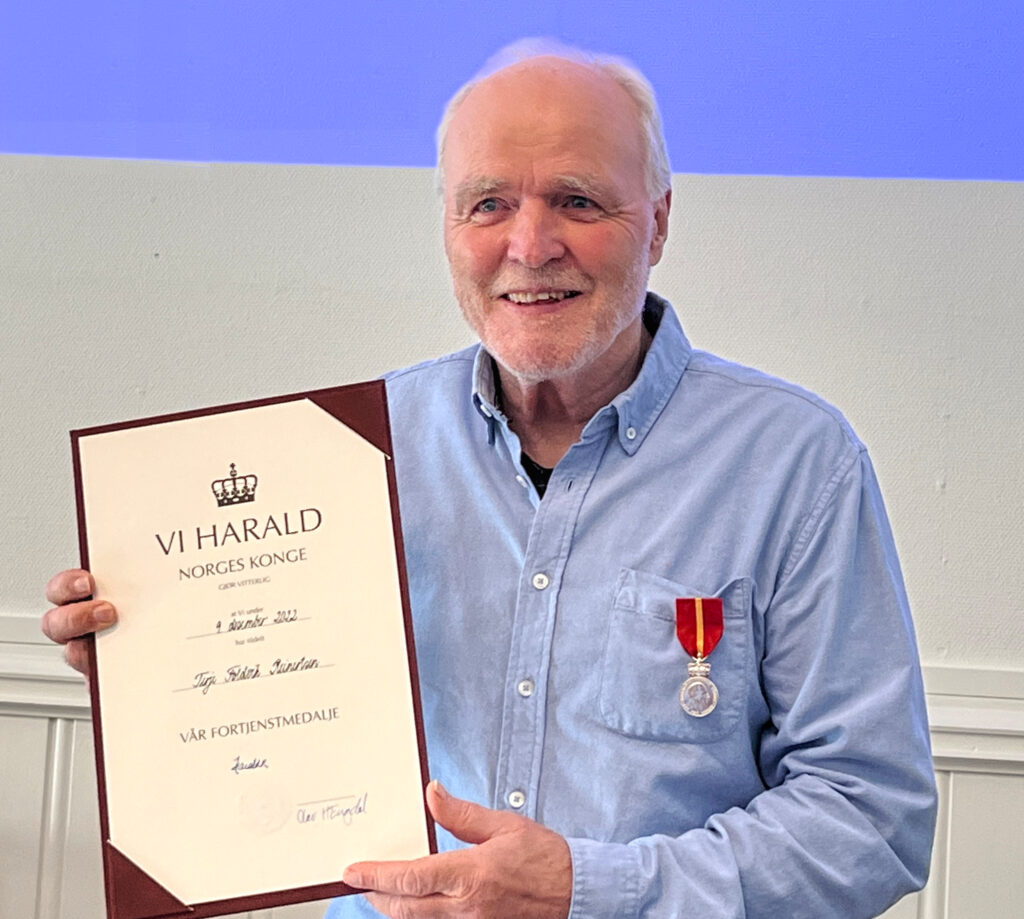
Melissa started her research on Terje’s bees, which are located just north of Oslo. There is now a carnica bee breeding project in Hurdal, on the same level as Jämtland, a county in our neighboring country Sweden.
Her investigations of Terje’s bees have yielded interesting facts. In mid-May 2020, the natural drop of mites averaged about 5 mites/day and varied slightly up and down during the summer. Towards the end of the summer, the average increased slightly. The last measurement in mid-August showed about 9 mites/day. The next year in mid-May it was again about 5/day. The collection was done weekly.
In a non varroa resistant control group in the same apiary the first measurement gave about 6 mites per day. The number increased quite steadily throughout the season. In mid-August there were about 35 mites. It should be remembered that the control group consists of bees that are normally treated regularly against varroa.
Another observation was that colonies produced more mites in bad seasons and less in good years.
Melissa Oddie discovered during her studies of Terje Reinertsen’s bees that something called recapping was responsible for their varroa resistance. Subsequently, resistant bee strains have been studied in different parts of the world. The more resistant, the greater the percentage of mite infested brood were uncapped and soon recapped again.
https://www.nature.com/articles/s41598-021-88592-y
The bees identify capped cells of worker brood in which there are varroa mites. They uncap these capped cells. Uncapped cells with pupae have been called bald brood. Recapping means that the bees recap the pupa with a wax cap again, without removing the mites. However, this behavior obviously has a negative effect on the mite’s ability to produce mated offspring and also a negative effect on the life span of the mother mite.
The number of mated offspring to mother mites in Terje’s bees is measured at 0.87. In non-resistant bees (called susceptible) it is measured at 1.24. 0.87 is less than 1.00. A value less than 1 has the effect that it’s easier for the bees to control the varroa population.
Hygienic behaviours
Recapping is a hygienic behavior (HB). There are several different variants of HB. One is what is called VSH (former called SMR) where worker brood cells with mites that have offspring are identified and then uncapped and removed. A similar one is when the bees also clear out mites without offspring (and the host pupae). There are bees that also clear out drone brood with mites. A previously noticed hygienic behavior is when bees clean out dead brood, such as dead from American foulbrood or chalkbrood, quickly after the brood has died. This prevents the spread of such diseases.
It has been shown that bees resistant to varroa, through hygienic behavior against mite infested brood, also quickly clear out dead brood, including needle-killed or freeze-killed brood for selection purpose. Needle-killed or freeze-killed brood, counting the time for removal of it by the bees is used to select for HB. But such selection does not bring about as rapid an increase in varroa resistance as selection on low amount of natural mite drop or measurement of the infestation rate of varroa mites (through a bee shaker like Easycheck).
Recapping has a great advantage for the bee colony compared to other hygienic behaviors towards the varroa mite. Bee strength is not negatively affected. Recapped brood develops into mature worker bees.
The Hurdal project
The Carnica population in an isolated area in Hurdal started by purchasing 10 bee colonies from Terje Reinertsen more than 10 years ago. Carnica queens were introduced to these colonies as Hurdal is part of an area for pure breeding Carnica. Varroa control has never taken place in these colonies.
New queens are mated in the project area in Hurdal. The number of colonies has been increased by splits and is now just under 100. The winter losses of Terje’s bees are just under 5%. Of Hurdal bees winter losses are a bit higher, possibly due to that colonies with higher mite load are not removed from the area. Their drones may affect the matings and their mites may be shared with neighboring colonies until new queens regime in such colonies.
The amount of mites in the Hurdal bees is bigger than in the Terje bees, but they are resistant, i.e. treatment-free. The isolation from non-resistant (susceptible) bees contributes positively. In the beginning of Terje’s work on varroa resistance, his bees were not isolated from non-resistant bees.
Melissa’s project for a number of years now is to select the Hurdal bees for less mites. The resulting effects are reduction of mites in brood and increased recapping. Selecting on recapping is difficult and labor intensive. It is easier to measure the mite population. She has chosen to measure average daily natural drop of varroa. The varroa tray grid remains on the bottom for three weeks, then the natural fallen mites are counted. The quantity is standardized after the bee colony strength. The mite drop is counted three times during the season.
The count in August is the most important for selection. Among Terje’s bees, 80% had collected 0-10 mites per day. Among the Hurdal bees, 55% had 0-10 mites/day. Among control colonies 20% had 0-10 mites/day. Terje’s bees and Hurdals bees are treatment-free, but the control colonies are treated against varroa every year. It is in the group 0-10 mites/day that you can find candidates for breeder queens. It should be possible to start a selection work also among the control colonies. Another finding is that the fastest development of resistance occurs in populations with greater genetic variation than narrowly bred and mated bees.
Melissa Oddie ends her lecture by pointing out 4 things that have been shown in Norway:
– Bees are not defenseless against varroa mites.
– Treatment-free colonies maintain low mite levels.
– Most treatment-free colonies have a daily natural mite drop of < 10 per day.
– Recapping is not stable (consistent) in terms of % of infested brood cells when mite population is low, due to varroa treatment or varroa resistance traits.
.
Treatment free bees in Sweden
In Hallsberg, in the middle between Stockholm and Gothenburg, there is a lot of activity to help beekeepers to treatment-free beekeeping. The annual conference is financially supported by the county association. The local association has courses, meetings and mentors who provide support and tips. One of the members has a website with lots of information on how to gradually reduce miticides. The miticide they have been working with is 2”x2” cellulose dish cloth (without dish chemicals) 5g thymol pads. When you are down to one piece/season, you can stop treating. Yes, there are examples where some have stopped at 2 pieces/season. The information can be found on this link: https://www.elgon.es – click on Gradual resistance. The strain of bees in the treatment-free area i Hallsberg is called Elgon, a variety of Buckfast bees, a combination with some Eastafrican mountain bee heritage (Apis mellifera monticola).
A group of active members in the work for breeding resistance ensures that beekeepers are offered splits, laying queens and mature queen pupae for those who wish to strengthen their apiary with good genes.
A mating site of the local association in the middle of the area with treatment-free bees is open for mini nucs for those who wish to have their virgin queens mated with good drones. This is especially suitable for those who are situated closer to susceptible bees, also further away from this local association. Otherwise, the most suitable mating normally takes place in your own apiary when your neighbors and you have a good genetic treatment free quality of your bees. But there are successful examples even when the circumstances are not ideal. About 15 beekeepers in the Hallsberg area are currently treatment-free. The first treatment-free colonies have been so since 2015.
Some of the association’s members have formed an association type company with the intention of selling TFB honey from the county Närke (where Hallsberg is in the middle) to retailers in this county. The goal is that the honey is purchased from beekeepers with treatment-free bees or whose bees are about to become so. Because of the present difficult market situation, the association wants to help beekeepers sell their honey.
The local beekeeping association in Varberg, a town to the southwest in Sweden, is very active with courses for new beekeepers. They point out that it is important to present the various possibilities for controlling the varroa mite, including the use of pesticides. But because of the experiences with treatment free operations that exist, you get great help if you want to avoid treatments. Today there are 15-20 beekeepers in the Varberg area who are treatment-free. The first treatment-free colonies there have been so for at least 8 years.
They collect many swarms, which can come from known and unknown places. Surprisingly, about 80% remain treatment-free for more than 2 years. Initially, they are not placed in apiaries with the already treatment-free bees.
They have acquired bee colonies from Hallsberg, but one branch of their bees is derived from an old beekeeper who sold his bees several years ago. They were never treated. Some of the heritage of these bee colonies contribute positively to the area’s population.
The example of Sibylle Kempf
Sibylle Kempf settled a short distance from Hallsberg when she moved from Germany. She bought three Elgon colonies from Hallsberg in 2019 that were almost treatment-free. Since then they have been TFB, yielding splits which produced their own queens. There have been no winterlosses with them. She has purchased some swarms from the outskirts of Hallsberg and some colonies from near Hallsberg, all Elgons. She is now wintering 13 colonies. The nearest apiary with non-resistant bees is 1 mile (1.5 km) away, with 15 colonies.
Her success may be due to good treatment-free status of the bees started with, small entrances on the hives that help the bees to defend themselves against ”silent” robber bees and keep out some reinfestation mites that way. Her colonies can make a lot of drone comb if they want to, resulting in many and viable drones early in the season. The neighbor’s drones will not be as numerous (drone brood removal) and not as vital due to mite control chemicals. And maybe the neighbor saves only small amounts of the bees’ honey for winter food (=less vitality?), which is quite common in Sweden. And if Sibylle’s queens mate with 5 of the neighbor’s drones, out of about 20 in total, it doesn’t matter much. Maybe it’s positive for the genetic variation.
The example of Peter Rishede
Peter Rishede from Halmstad in south west of Sweden bought 2 colonies from Hallsberg in 2018, which were almost treatment-free. Since then they have been TFB. He increased to 4 hives. He started with medium langstroth sized frames in square 13-frame boxes. He soon reshaped his hives to longhives with 50 frames. Always on just one storey. Insulation on top 2” (50 mm) rockwool. Wintering is always on about 20 frames. There is smaller honeycrop than from stacking boxes on top of each other. He saves a lot of honey in the hives for winter. He gets an odd swarm every year. He likes the easy beekeeping of the longhive. There is about 2 miles (5 km) to susceptible bees.
.
Summary of experiences in Hallsberg
Brief management experiences
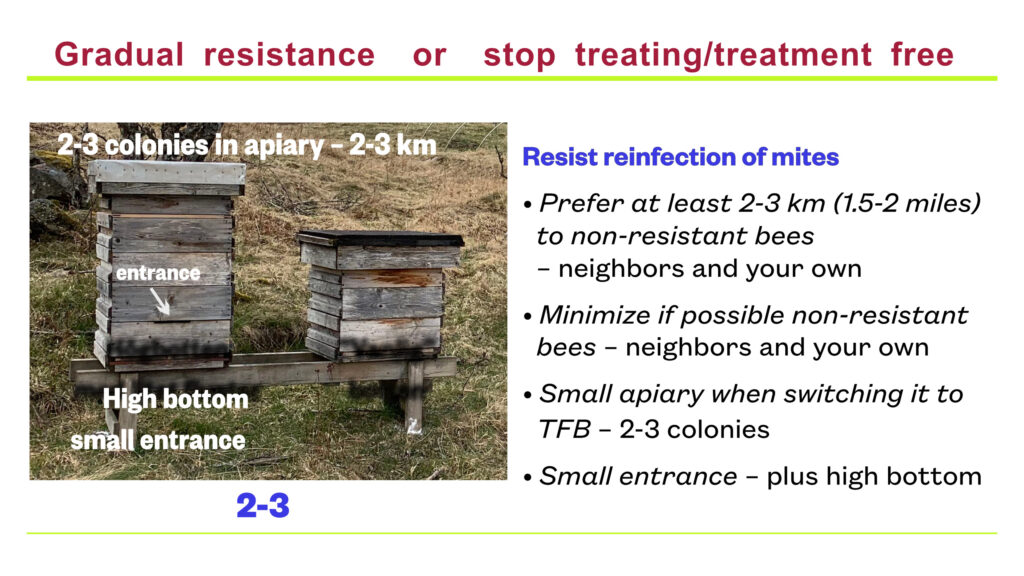
– 2-3 colonies in a starter apiary and 2-3 km (1.5-2 miles) to other bees. This suits an apiary you are starting up that will be or already is treatment-free.
– Preferably you do this with bees that are selected for varroa resistance. The very best is splits from TFB colonies due to their healthy microbiome. It is suitable whether you choose gradual development of resistance (see https://www.elgon.es -> Gradual resistance) or abandon pesticides quite immediately.
– Adequate distance from other bees protects them (and your own) from spread of mites.
– Small entrances help bees to defend themselves.
– Small cells (at least a few combs in the center of the brood nest) and good pollen and nectar availability (good forage) maximize viability/fitness.
– Once freedom from treatment is established, feel free to increase the number of colonies in the apiary, with splits from selected colonies.
.
4 guidelines to help select bees.
In case of gradual resistance

1. Measurement of the infestation rate, e.g. with a shaking jar and technical alcohol (EasyCheck), at more than 3% (9 mites/300 bees, 1 dl), treatment with 5 g thymol pads (see the link mentioned above). Thymol is the only treatment substance we in Hallsberg know works for gradual resistance,
2. Control of hard board 2 x 2 feet (0.6 x 0.6 m) in front of the entrance every week in the morning. Check for presence of wing-damaged bees (DWV = Deformed Wing Virus). See link above,
3. expected development of the colony or absence of it (check the brood nest if bad development),
4. presence of at least one area of a palm with densely capped worker brood.
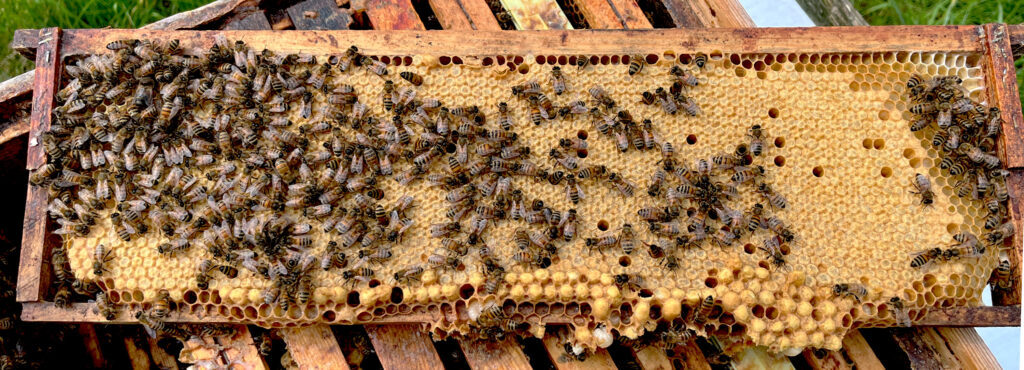
.
In case of treatment-free colonies
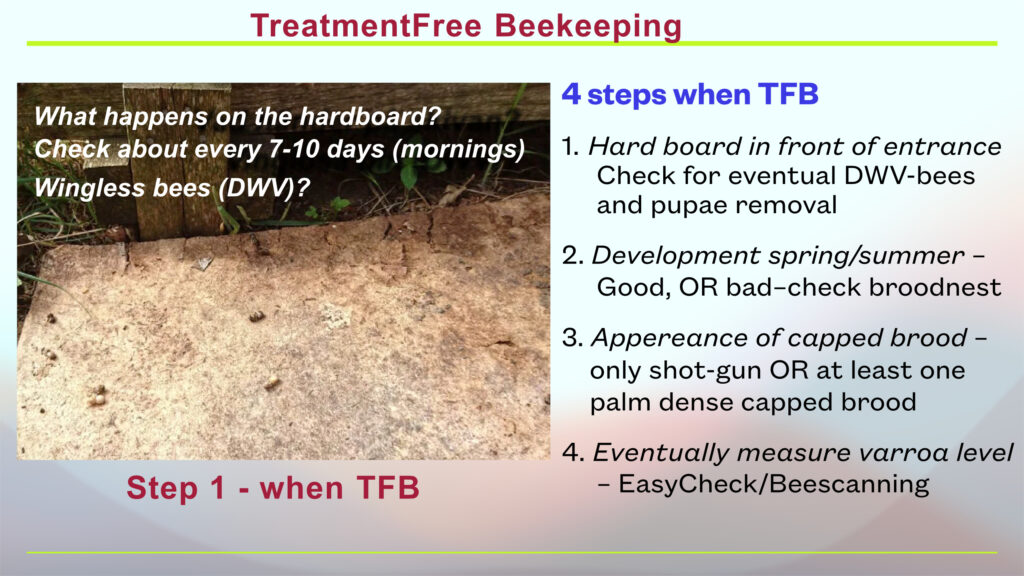
– No. 1 is moved to No 4 compared to gradual resistance scheme above,
– No. 2 moved to No 1, No. 3 to No. 2 and No. 4 to No. 3.
.
After 3 years of no treatment in Hallsberg:
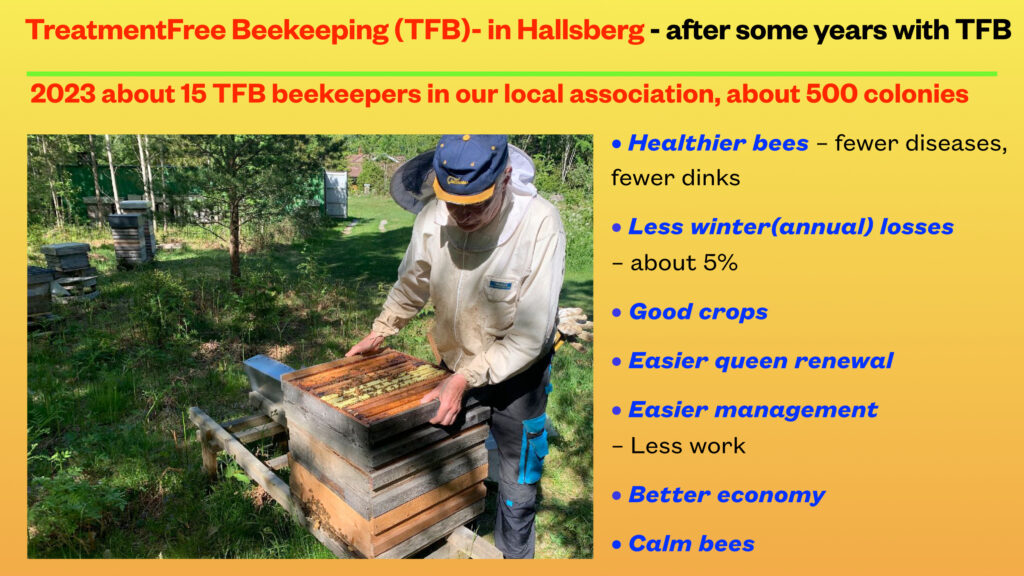
– winter losses have stabilized at about 5%.
– fewer diseases, e.g. chalk brood only sporadically
– a few dinks, weak colonies that do not develop (requeen!)
– good crop
– easy queen renewal, e.g. mature queen pupae to colony splits
– queen mating in your own apiary
– Less work and better economy
– good tempered bees
In conclusion, we have a more easily managed and satisfying beekeeping system.
